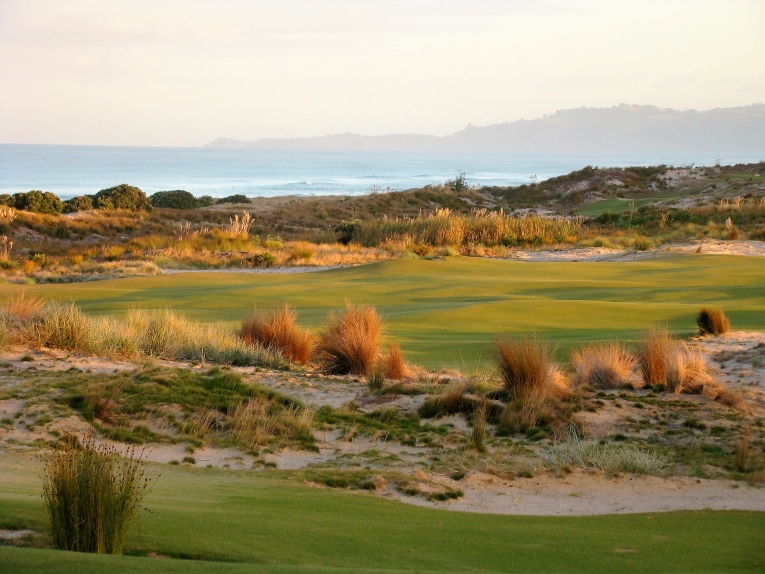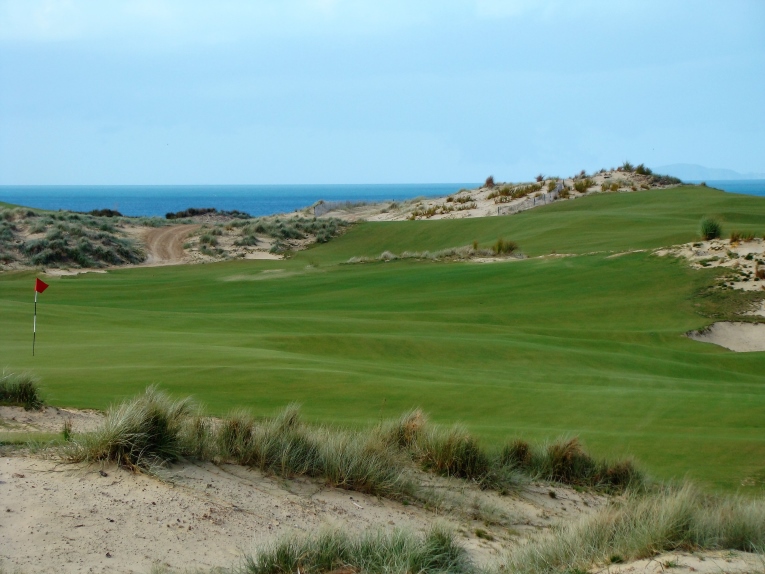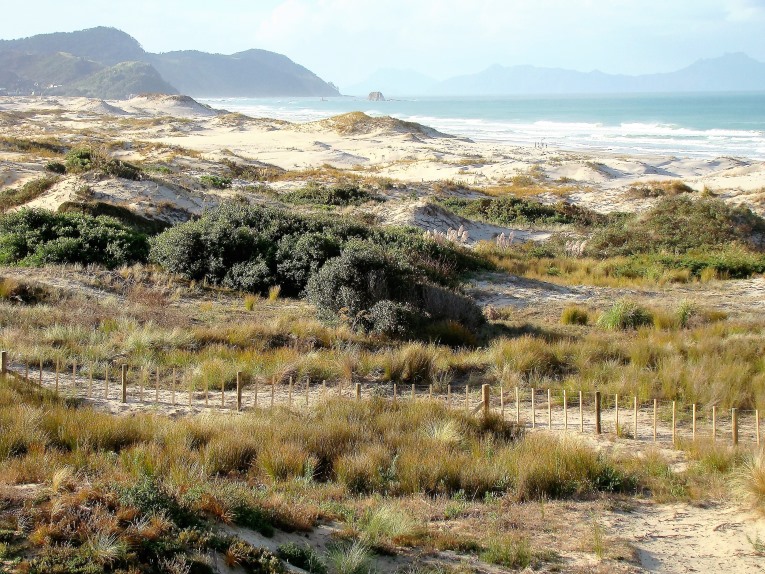Tara Iti Golf Club
North Island, NEW ZEALAND
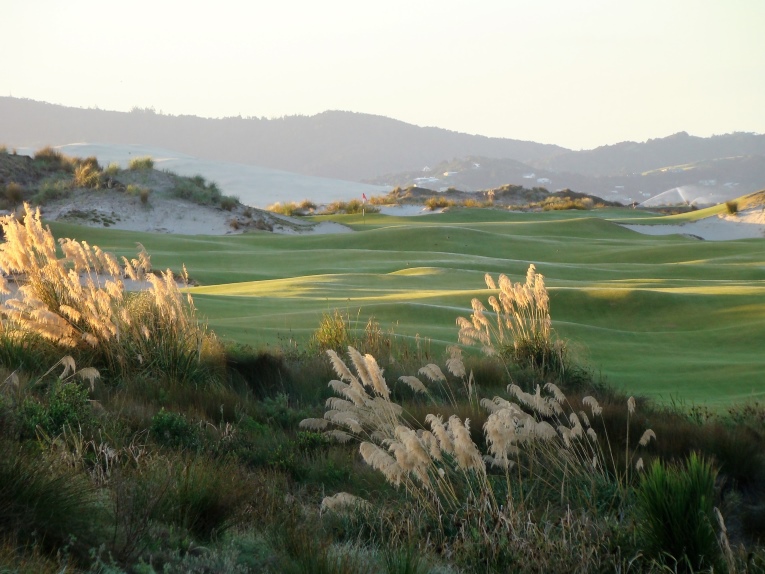
The Pacific Ocean is nice to play beside (!) but the quality of the golf – not the views – is what makes Tara Iti special.
Imagine the thrill that golfers received when Pebble Beach opened in the 1910s, Cypress Point in the 1920s and Kawana in the 1930s. Here was superior architecture laid along and sometimes over the shoreline.
As populations expanded, environmental concerns did too and rules and regulations arose. Decades went by with only a few courses built on scintillating coastal property.
Beginning with Pete Dye in the 1990s at Kiawah and Kohler, golf re-emerged with eighteen core holes alongside a large body of water. More than anyone, Mike Keiser lead the proliferation of this exhilarating brand of golf worldwide. Happily for us golfers, the most talented architects largely enjoyed the privilege to work in such special locations and these magical opportunities have not been squandered. Courses from New Zealand to Tasmania to Scotland to Nova Scotia have muscled their way onto the various world top 100 lists. There were a few misses along the way (South Africa, Ireland) but in general, what’s not to like? Where there’s water, there’s usually wind and sand, the two critical elements of great golf.
And yet … as the drumbeat goes on and on with one spectacular waterside course opening after another, those water views remain enchanting but less unique (admittedly horrible English but the point is made). Indeed, the traveling golfer rarely flies to a different continent or hemisphere without the prospect of playing such golf.
Yes, modern golfers are spoiled but also finicky. Now that we have been deluged with so many wonderful views, we realize that water is water. It is wonderful and it elevates the spirit but it is only a backdrop. At some point, the true golfer – by definition – turns to the golf. And that’s a scary moment for resorts/clubs/owners. Forget the million dollar views – how good is the golf? In the end, that is what matters.
As a member of Stone Eagle and Sebonack, Ric Kayne had long admired Tom Doak’s work. When it came time for the Los Angeles based financier to build his dream course, he knew who to hire. Finding a property that would unequivocally yield a world class course was the challenge. After discarding several sites, his New Zealand partner John Darby (an architect in his own right – Jack’s Point is a noted example) made Kayne aware of a block of coastal property some 80 kilometres north of Auckland.
A Maori tribe was happy to part with the property that was covered with non-indigenous pines that had even been farmed. Armed with a topography map with one metre contours, Doak roamed the land for five days, staying back from the Outstanding Natural Landscape (ONL) designated line that makes its way in a jagged, irregular fashion along the coast. According to Doak, ‘A lot of the routing came together during this initial site visit. The only thing we could see on our first day was a narrow clearing that John Darby had made from the old logging road, to show the line out to the islands referred to locally as the Hen and Chicks. There was a dune close to the shore sitting up high that looked like the green site for a short hole to me. Then, my first look at the map revealed a long, low dune ridge that started near to the shore and worked diagonally inland. By the end of day 2, that ridge was the background for the 5th green, the tee for the 6th, the background for the 7th, the tee for the 8th, the green site for the 9th, the clubhouse site, the tee for the 10th, and the green site for the 18th, with John Darby’s dune 500 yards down the beach becoming the par-3 17th. The loop from 11 through 16, built last, was the only part of the routing that evolved much between our first visit and the final plan.’
Kayne secured the property as it was evident that the site would work. The next task was the removal of the non-indigenous pines and debris. As Brian Slawnik, Tom Doak’s Lead Associate for the project, recalls, ‘The undergrowth was overgrown, especially the thick, low-lying Australian wattle which made parts of the property impenetrable to walk.’ As the property was cleared, the excitement rose because the open sandy landscape juxtaposed against the teeming blue water was exceptional. Yet, even after controlled burns, stumps, roots, and debris remained on a large scale. Slawnik worked with Phil Vautier from Darby Partners and they did a masterful job of piling the slash to the side and covering it to create some of the bigger dunes on the course. So good was their work that no one knows which dunes were there and which were made. Only by prying it out of Slawnik does one gain an appreciation of how a hole like the eleventh blossomed from the addition of these man-made dunes.
As there was no native vegetation beneath the trees, Tara Iti was built out of sand and then re-vegetated. To oversee grow-in, Doak recommended to Kayne that he hire CJ Kreuscher, a crack golfer to boot. Kreuscher had assisted with Old Macdonald, also 100% fescue. CJ fell in love with the course – and place – and remained as Green Keeper. After doing due diligence, Slawnik and Kreuscher selected various native plants to stabilize the shifting sands. Slawnik states, ‘The balancing act was crucial. We needed to hold the sand in place while still providing the sense of an open, expansive dunescape.’

The front nine is more mature and the author considers the current mix of vegetation and sand to be nearly perfect.
One native plant, the spinifex, became an exceptional find. Golfers love its aesthetics and playing qualities while the spread of its runners has been remarkable. Best yet, it doesn’t handle foot traffic well so golfers tramping around help keep it in check (this contrasts to marram grass which proliferates underfoot).
Various folks from Doak’s Renaissance Design Firm came in to help. Eric Iverson and Brian Schneider made guest shaping appearances to help out on greens, Kye Goalby with two long stints of finish work, and the finish crew of Clyde Johnson, Michael Henderson and Pete Zarlengo, who helped restore all of the smaller contours lost to the tree farm.
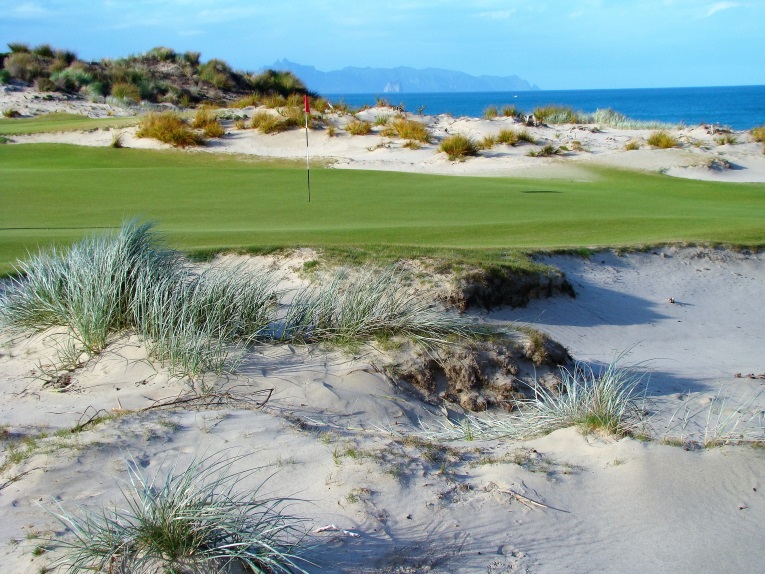
Note the attractive coloring/texture of the light green spinifex and how quickly it runs to provide stabilization. Overstating Kreuscher’s efforts to control the shifting dunes is impossible.
As a point of interest, there is no formal bunkering on the course; everything is treated as ‘through the green.’ By and large, bunker depth doesn’t cause as much misery as the dicey, dodgy lies. Because there is limited play, rakes are not needed, so that the sandy wastes are truly hazardous.
Like Shinnecock Hills, the two nines while cut from the same cloth feel distinctly different. The first nine at each course is – relatively speaking – over the more subdued property and more intimate (holes three and five cross-over at Tara Iti) while the second nines are spread out and occupy more tumbling ground. At both sites the interaction with the clubhouse on their respective high ridges is superb but for opposite reasons. At Shinnecock Hills, the historic Stanford White clubhouse proudly lords over play while at Tara Iti discretion carries the day and the earth-toned clubhouse melds into the surrounds without dominating the scene.
One can only imagine what it would have been like to see this course arise from the sand. What the author marvels at most is just how different each hole is. Sometimes a course with a homogeneous environment ends up with holes that blur together. Not here. Equally impressive are the extraordinarily pure sight lines where the entire landscape is devoted to golf. One wonders how the maintenance crew gets around or where the maintenance facility is even located. As the golfer meanders the property, the picture is one of tight fescue contrasted against sand and ocean. No ball washers, benches, or anything to impede the uncluttered environs, save the low-slung clubhouse.
Holes to Note
First hole, 390 yards; This hole is a curiosity: a dogleg opening hole. Not many opening holes are. Only the first at Merion, Hoylake and Bethpage Black spring to mind among the world elite. This one is in the Merion vein as the hole isn’t overpoweringly long. You can actually try and shape shots, which makes for a tactical, congenial way to start the round.

The view down the first fairway, which elbows left. As an aside, the practice area and first tee could not be better integrated as you walk off the former onto the latter.
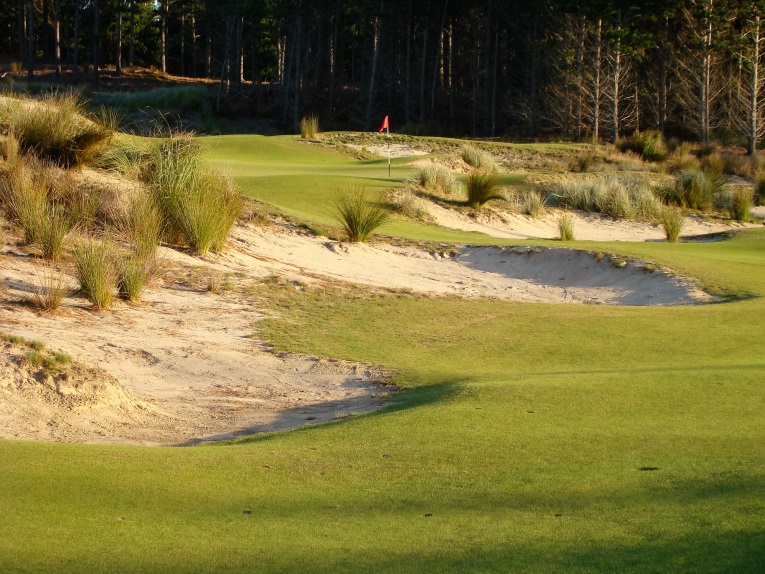
Benched into a dune, the appeal of the day’s first approach shot is evident. Misses slightly left often receive a friendly nudge right, which makes for a cheerful start.
Second hole, 170 yards; Ric Kayne enjoys many luxuries. One was to exclaim ‘My house overlooks that hole at Riviera!’ when Doak decided to build a bunker within the second green. Life in the fast lane!
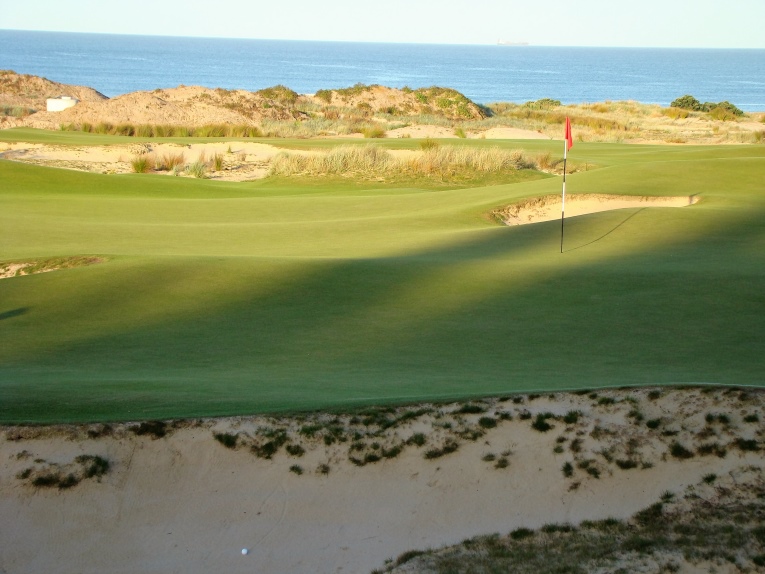
Similar to the sixth at Riviera, it isn’t the bunker internal to the putting surface that bothers the golfer as much as it is the configuration of the green and its contours. Doak has been occasionally criticized for building overly severe putting surfaces but every great course should have one that gets under the golfer’s skin – if he is weak enough to let it.
Third hole, 445 yards; Most modern two-shotters enable a view of the flag or green or both. This breaks the mold, at least most of the time. The golfer might feel like Christopher Columbus as he sails down a bumpy fairway to where ….the edge of the earth?! There is no flag or green or aiming point for one’s approach. For that unlikely reason, this hole was the unanimous favorite among the cognoscenti that attended the 2016 Renaissance Cup. Even though this is the thirty-fifth course Doak has built, he keeps coming up with original concepts and designs. Experimenting with ways to use the banks to get one’s approach to stop on the different portions of the sunken green is endlessly fascinating. It’s also an example of how well Kayne and Darby partnered with Doak during construction. Additional land was necessary for the creation of the last half of this one-off hole as well as the fourth tee. According to Doak, ‘When Ric and John Darby asked if more ocean frontage would make the course better, and I volunteered that getting another 250 yards to include the 3rd green site would be ideal, they renegotiated the sale to include that piece.’ It is a prime example of the owners giving the architect the freedom to create while offering crucial support when needed.

More perplexing is this sight from 175 yards out! The golfer has to take it on faith that the green is between the dune in the foreground and the one in the distance.
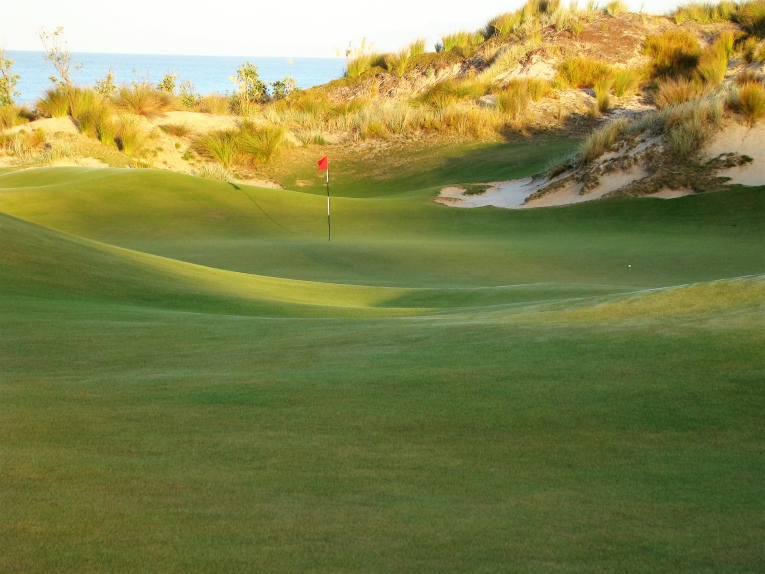
Only when the golfer gets within fifty yards of the punchbowl green does the flag in this back left hole location reveal itself.
Sixth hole, 460 yards; The most demanding hole on the course is also the closest to the Te Arai beach, so the golfer might not mind the mugging that occurs. The tee shot is striking, played across a valley, but the real issue is finding a level lie on the course’s most relentlessly lumpy fairway. That’s important because most players will be reaching for a utility club to get home and the resulting awkward stance to a green that is slightly above (and often into the wind) is a recipe for further travails. The coup-de-grace is the green, with its uncaring back to front slope and nuanced contours.
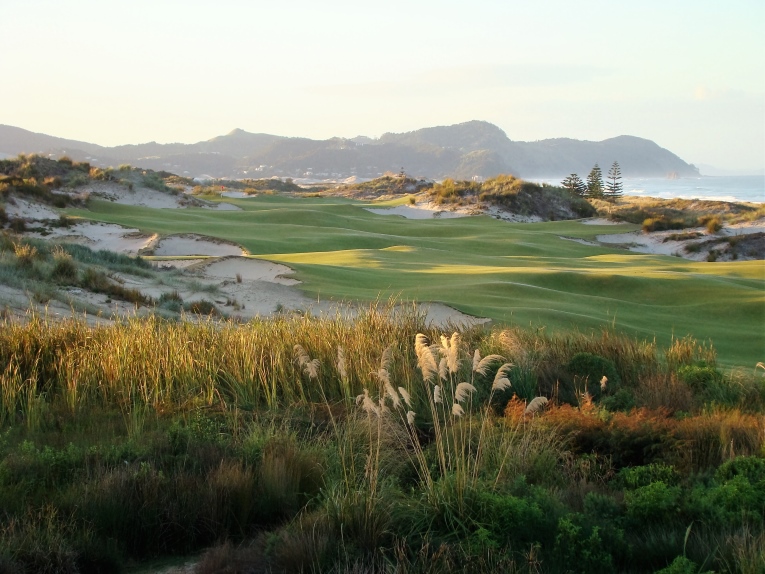
Cry, cry, cry – no level lie! A round of applause for the construction technique that preserved/captured so much random movement within the fairway.
Seventh hole, 290 yards; Parallel and opposite the sixth, the two holes could not be more different. Under normal wind conditions, this one plays over two hundred yards shorter. Thoughts of driving the green dance in one’s head but the author is convinced that over an entire playing season, laying up on a Doak short 4 will produce superior results. That sentiment is solidified here once the golfer gains a full appreciation of what confronts him at the green. Ripped right out of one of Doak’s favorite courses (Pinehurst No.2), the banks and green configuration shed anything less than a perfect shot. After getting punched at the sixth, many golfers look at the card – and hole – seeking revenge – and that’s when the trap springs.
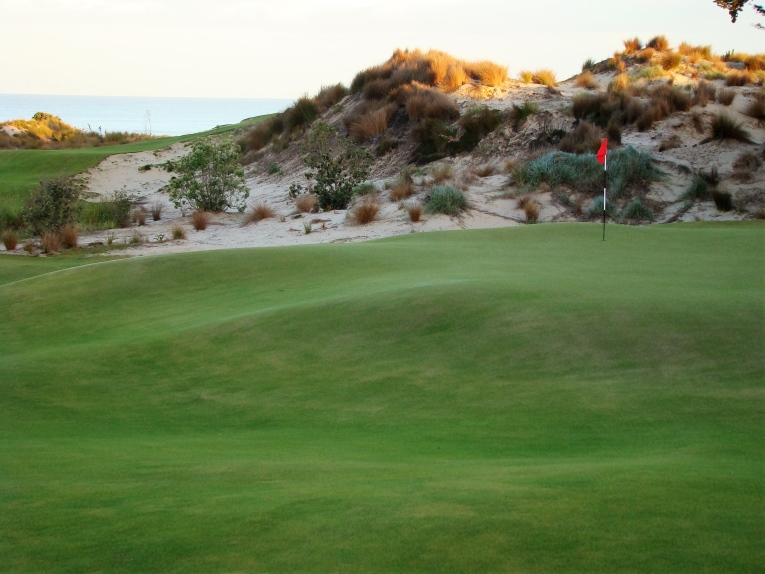
A cruel hole location, the tiny seventh green is hard enough to hold with a short iron, much less a driver!
Eighth hole, 430 yards; Several of the holes that play away from the Pacific are particular favorites of the author, including this one, the first and twelfth. A bunker, expertly cut into the ridge line, protrudes into the fairway from the left and dominates play, exacerbated by the wind and the green’s right to left tilt. Downwind, most of us will attempt to carry the bunker because the reward of an easier approach is emphatically worth the risk. Against the wind, some golfers erroneously steer too far right away from the bunker, which leads to a dreadful cross-angle over a bunker to a canted green. Better to play in line but short of the fairway bunker seen below, and thus preserve the angle into the green.
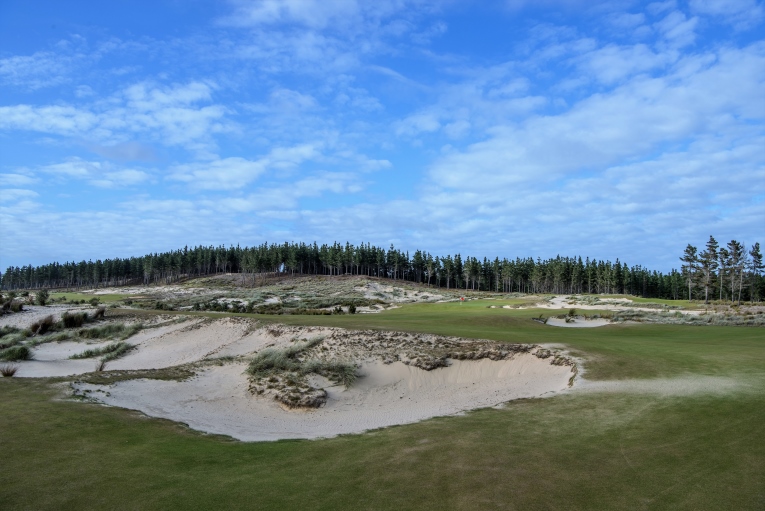
The fairway bunker left and greenside bunker right create the playing dilemmas at the eighth. Note how the fairway beyond the bunker slopes away, helping to propel tee balls all the closer to the green. Photograph courtesy of Joann Dost.
Ninth hole, 470 yards; Even when the trees and dense underbrush hid many of the neat landforms, Doak spotted a V trench just off the main ridge line. Instinctively, he knew that it could be a greensite. Ultimately, the V was softened into more of a U producing a unique green complex wonderfully close to the clubhouse. Indeed, what are some other first rate natural green sites for a returning first nine? The list isn’t long as the act of returning to the clubhouse is often contrived. Not here though. Slawnik has enjoyed witnessing the early play and noting how quickly golfers have taken to using the banks and slopes around the greens (especially those on the front) to improve their scoring.
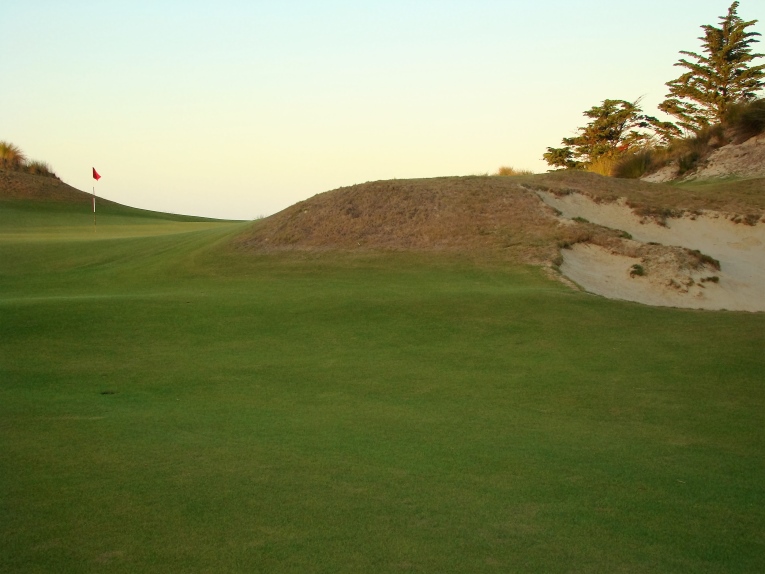
The scar bunkering on the front right dune at the 9th green resembles Alister Mackenzie handiwork at the stylish Valley Club of Montecito.
Tara Iti Golf Club
North Island, New Zealand
Eleventh hole, 535 yards; Supremely routed, the tee and fairway take maximum advantage of the property’s broad slope and the tight fescue. The approach on many days is the author’s single favorite shot on the course. After a power fade off the tee, the downhill green is often in reach by a bullet played as far as forty yards left of the edge of the green (and therefore over seventy yards (!) away from certain back hole locations). Aiming away from a flag (the 12th at Augusta, the 17th at TPC, the 17th at St. Andrews) requires a discipline that most players rarely develop. On soft fairways in North American dull point-to-point golf ensues and there’s no need to cultivate an imagination. Here, the ability to visualize a shot played along the firm turf is of paramount importance. To see a well-executed approach unfold – the white ball tumbling along the fescue – then veering right as it loses steam – trundling – onto – and then across – the putting surface is a joy to observe. This truly indelible moment seems suspended in slow motion, so prolonged is the ball’s journey.

Slawnik notes with pride how well the eleventh turned out. During construction, the hole initially seemed little more than a connector from the primary dune line out to the bolder features. Photograph courtesy of Joann Dost.

As seen from behind, the slopes that conspire to create a shot that takes 20 seconds to play out are evident. On most clay based courses, the hole would be ~ 1/10th as much fun.
Twelfth hole, 480 yards; The author has always admired abruptly uphill tee shots (e.g. the fourth at Pine Valley, the eleventh at Royal County Down, to name but two on world top five courses) as they portend exciting golf from an architect who likes to utilize the land in every manner possible. So it is here but the approach is the real scene-stealer and shares the playing attribute of the all-universe fifth at Merion where the golfer must gauge how far up a slope to sling his approach as the right edge of the green is seven feet (!) higher than the left. Lots of ways to play the broad slopes, which Slawnik says is “…what Mr. Kayne was specifically after. He and his friends like to have fun on the course by experimenting and inventing shots, so we tried our very best to give them as many options as possible.’ That ethos carries over into the life of this nascent club where parties are held at different spots around the property. To assist in that endeavor, the club owns a wood-fire oven on the back of a flat-bed truck and the silver mobile kitchen seen below. Today it was parked behind the twelfth green and tacos were served. Too many new clubs bog down under self-imposed stuffiness; that does not appear to be a worry here.

Even after this massive drive, the golfer might still elect to aim his approach between the tent and movable kitchen, and let the ball drift left down the tilted green to the hole.

The bunker lip in the foreground was built up to perfection by Slawnik and creates sixty yards of hidden fairway, which is best appreciated …
Thirteenth hole, 315 yards; Tara Iti’s design gleefully alternates between downhill holes that convey much to the golfer and holes with more hidden peril. At first glance, this reachable hole with its wide fairway seems harmless enough but like the seventh, one who strives for extra length off the tee often dooms himself to misery left where a fairway shoulder shunts balls left and down into dune country (hidden from the tee). Familiarity breeds respect and most will opt for a hybrid off the tee, though a lay-up isn’t straightforward. A left central bunker and a clever knob front right on the green work in tandem to keep the golfer on his toes. As he edges away from the bunker, the greenside knob becomes more intrusive for his approach. Many golfers carry the knob only to find that their ball took the soft shoulder of the green (hidden behind the knob) and was whisked right and away.
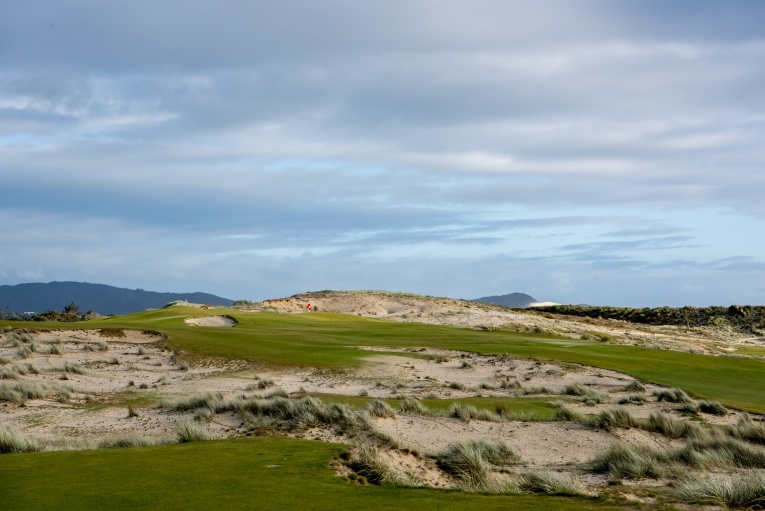
Sandwiched between two burly two shotters is this little beauty played uphill to a green that occupies the high spot on the course (a tip-off for potential anxiety given the windy environs). Photograph courtesy of Joann Dost.

See the ball lower left? It was once within twenty paces of the front edge of the green, for what would have been a potential eagle putt. Now any score is possible on this insidious creation.
Fourteenth hole, 455 yards; Perhaps the widest fairway in New Zealand, the golfer nonetheless dearly loves to find the relatively small plateau that hugs the inside of the fairway as it bends left around a dune. From there, he can see the putting surface and enjoys many more options, especially how he can approach certain right hole locations. Is the fairway super wide? Yes. Can an advantage be gained by driving to a particular portion? Most definitely, and that means players of every level will have fun. Tara Iti’s canvas needed to be massive to allow players room to maneuver around in the wind; that part was a given. What could only come during construction was finding ways to lace the holes with subtlety and variation.
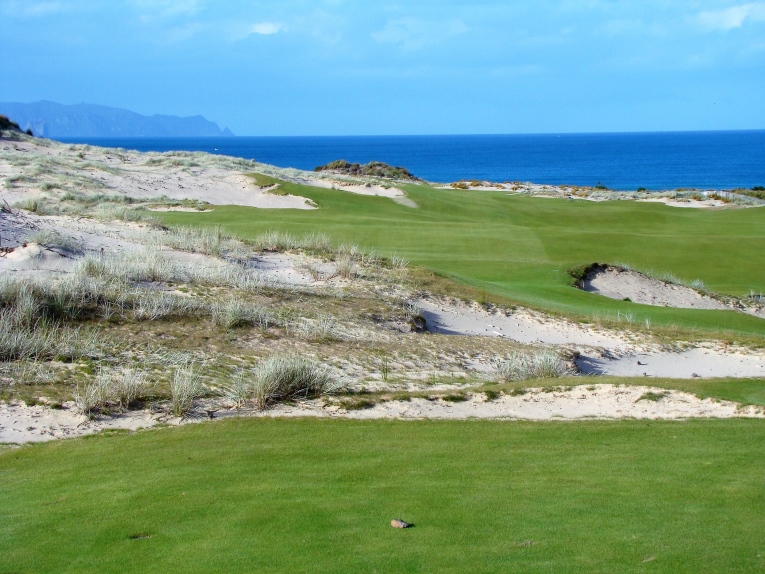
The fairway cants left to right but the hole elbows to the left. A draw that hugs the inside and stays left of …

… this mound is optimal and it allows the golfer to feed a running approach onto the open green. Otherwise, as seen above, the golfer right of this mound suffers progressively crummier angles as his tee ball edges right.

This front left depression is particularly adept at sucking in balls played from the right half of the fairway.
Fifteenth hole, 180 yards; One of Kayne’s favorite courses around New York City is Baltusrol Lower, where RT Jones silenced his critics by scoring a hole-in-one on its fourth hole. Tom Doak performed almost as well in the 2016 Renaissance Cup, which he won for the first time. Partnered with CJ and in a tight tussle when the match arrived here, he was greeted by a front right hole location. To the architect’s credit, under intense pressure and broad scrutiny he hit the required high soft fade to twenty feet. The ensuing par turned the match point and victory was secured at the next. Similar to Cypress Point, the last big two shotter at Tara Iti occurs at the fourteenth and two spectacular one shotters make-up half the remaining four holes. According to Doak, ‘The fifteenth was built on top of a small existing dune with the bunker lip front left a natural. There was even more tilt toward the back from there originally, so we had to cut along the right side and build up the back of the green, even though it is still a foot or two lower than the front.’
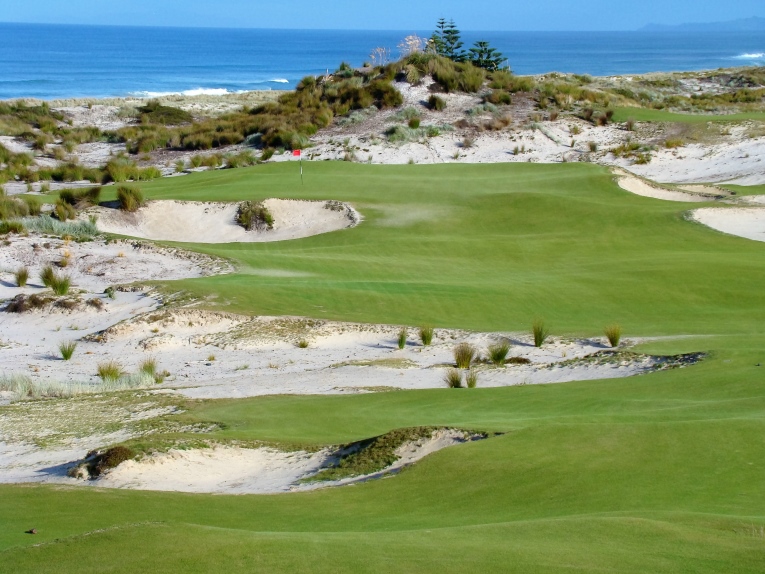
The mounds front and along the right are key playing elements. They can be used to deaden a fade for front hole locations or help a slight draw find back ones. The mound behind the green is not touched by the club as it is believed to be a sacred Maori site, home to a shell midden where their ancestors gathered to eat.
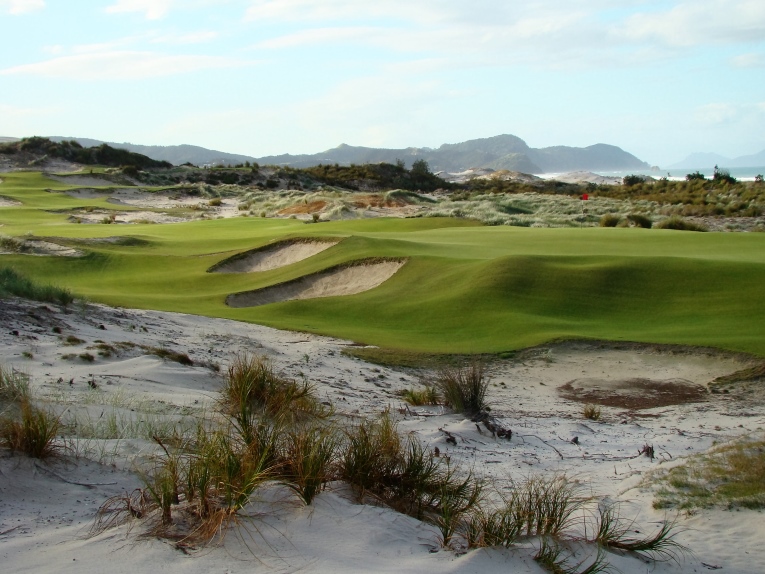
As seen from behind, it is worth noting that both one shotters coming in feature elevated greens. Hitting – and holding – such targets in the wind is always problematic. The fallaway putting surface at 15 is adept at shedding an over-cooked draw.
Seventeenth hole, 160 yards; Doak explained his vision to Kayne as the course unfolded and the two were in lock-step agreement – until here. Originally the hole, while stunningly handsome, featured a more subdued putting surface. Kayne didn’t feel that the penultimate hole – one of appealingly modest length – was multi-dimensional enough. Doak and crew went back to work and produced a green to better expose frayed nerves.

Doak’s equivalent to the rascally – and much beloved – 17th hole at Sand Hills is found in New Zealand. The impressive bunkers and the ‘Hen and Chicks’ islands in the background frame the hole while the bold green contours exasperate.
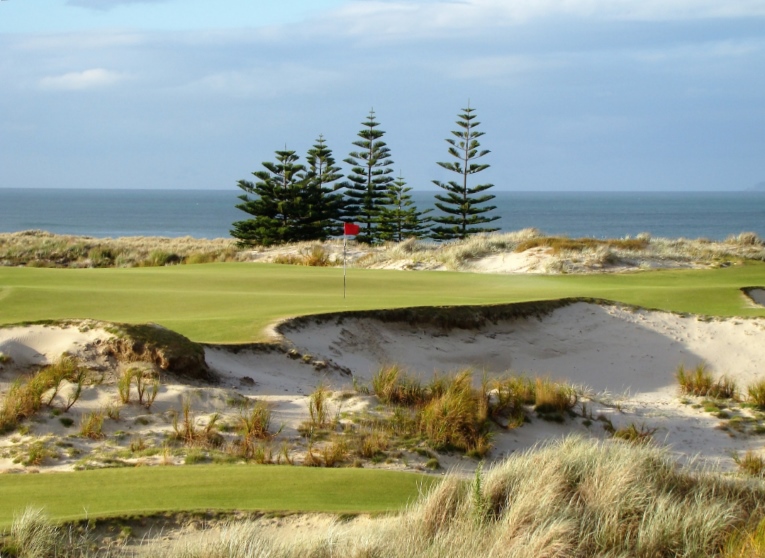
Ringed by trouble, only a well struck iron suffices. Finding the same part of the green as the hole location rivals the pitch to the seventh as the day’s single most precise shot requirement.
Eighteenth hole, 545 yards; The course and its holes seem particularly well-suited for friendly games in all wind conditions and it is refreshing to find a Home hole that encourages ebb and flow before the final outcome is determined. A player trying to ‘steer’ his way to the clubhouse is likely to flounder. All three shots hold appeal but it is the second that renders the most unintended consequences. Overall, the pacing of the course is quite nice; the round kicks off with the two highest handicap holes on the front and concludes with two holes that place more emphasis on execution and finesse than raw power. The sturdy middle stretch from 6 to 10 is where strokes mount.

The fairway snakes it way through dunes at an oblique angle to the green. Note the top of the red flag peaking over the dune on the right.
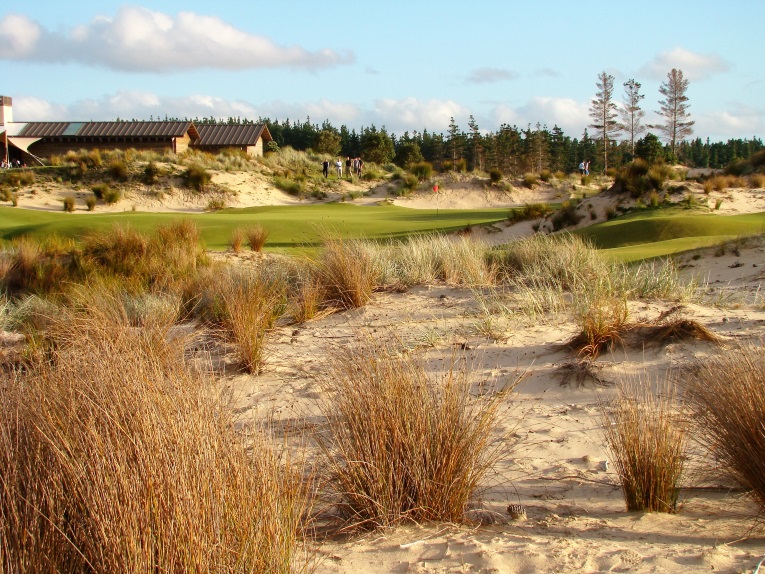
… while a high right extension of the fairway can be sought should the golfer wish for a level approach.
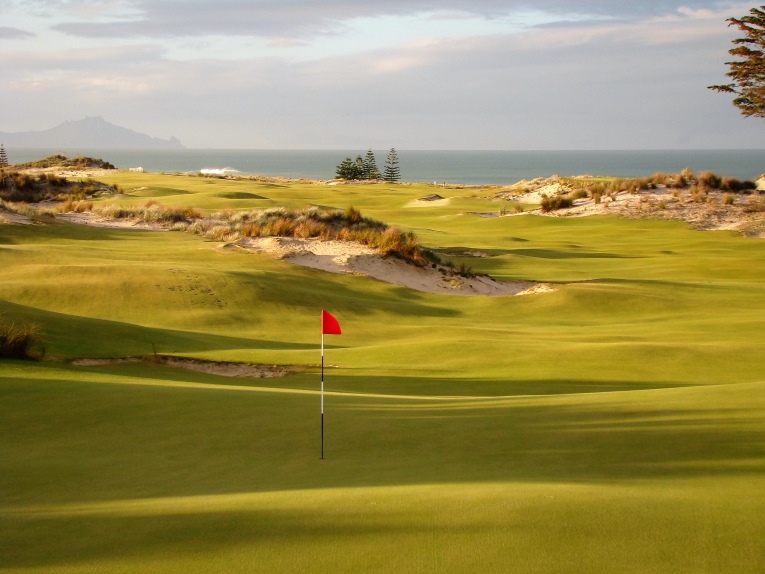
This view back down the Home hole highlights the free-flowing architecture that renders a multi-route hole. Imagine what a disservice to the landscape a linear fairway would have been!
As an example of how flexible and fun the design is, the author’s favorite moment during the 2016 Renaissance Cup occurred when noted Kiwi golf personae Michael Goldstein played the front nine with only his … blade putter! At the par 5 fifth he reached the green in two playing from the forward tee of 440 yards. Yes, the poor putter appears to have 5 to 6 degrees of loft but the thought of playing 99.99% of the world’s courses with just a putter doesn’t enter the mind. St. Andrews is the exception, a very telling sign!
From a design perspective, building an ultra-private course along a beach sounds like utopia, especially with just one man to whom to answer. Yet, the club’s location demands that most members travel a great distance. After all, popping across the Pacific for just a day or two is unlikely. But, when it is gray and gloomy in February in New York, imagine coming here to enjoy a summer month. Therein lies the rub. Few courses in the world invite play everyday. Some of the world’s best are too difficult, some are on the wrong soil, some lack wind, some enjoy fescue but too much rain. Getting all the components right leading to one fun match after another for a sustained period is the tallest order in golf design.
To everyone’s credit, that’s what was accomplished here with the golf being more than the equal of those darn gorgeous views of the Pacific.
The End


